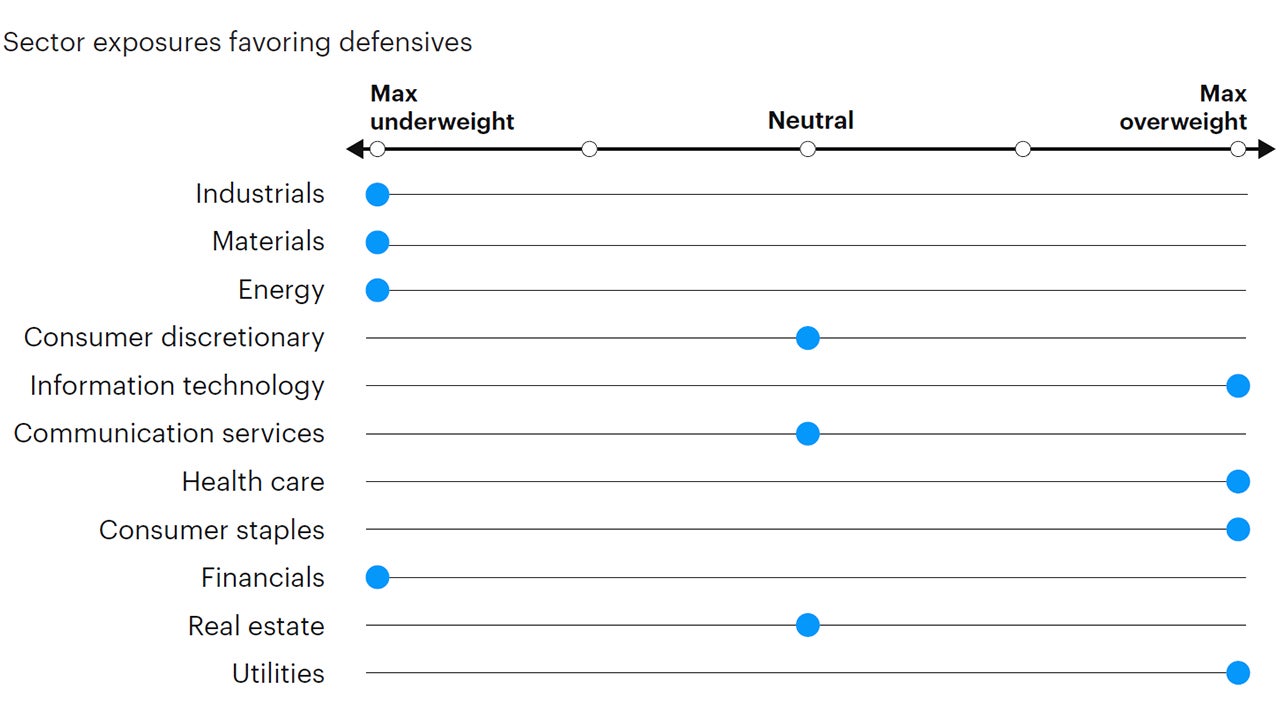Tactical Asset Allocation - May 2025

Synopsis
Earnings forecasts are deteriorating across developed and emerging markets, led by downward revisions in the United States.
Our framework remains in a contraction regime for the 11th consecutive month. We maintain a cautious asset allocation versus benchmark, overweighting fixed income relative to equities. We remain neutral developed ex-US equities vs. US equities, underweight in emerging markets and overweight defensive sectors. In fixed income, overweight duration via inflation-linked bonds, and underweight credit risk.
Maintaining defensive portfolio positioning, favoring fixed income over equities, and underweighting credit risk. Overweight low volatility and quality stocks and staying neutral developed ex-US equities relative to US equities.
Our macro process drives tactical asset allocation decisions over a time horizon between six months and three years, on average, seeking to harvest relative value and return opportunities between asset classes (e.g., equity, credit, government bonds, and alternatives), regions, factors, and risk premia.
Macro update
Following the 90-day pause on the implementation of US tariffs on most trading partners, equity markets have recovered most of the losses experienced in the first week of April, with the MSCI All Country World Index gaining more than 10% from the bottom registered on April 8, closing the month approximately unchanged and broadly in line with the global fixed income market, also posting marginally positive returns.
While on the surface April may have appeared to be uneventful, it planted the seeds for potentially meaningful shifts in economic and market trends. While hard economic statistics will take months to reflect the impact of global tariffs uncertainty on consumer spending and investments, surveys and financial markets are already pointing to a deteriorating outlook. The most notable declines are visible in US consumer sentiment surveys, reaching lows last seen in mid-2022, and US ISM employment surveys across manufacturing and services, falling respectively to 44.7 and 46.2. Despite the recovery in global equities, credit spreads have widened by approximately 20-30 bps over the month across sectors, ranging from investment grade and high yield corporates, bank loans, and emerging markets sovereign debt, pointing to a tightening in financial conditions at a time of weakening growth expectations. As a result, while leading economic indicators are yet to reflect the full adjustment due to a mix of survey-based and hard economic data, global market sentiment resumed its decline, and it is currently at its lowest level registered since June 2023, keeping our macro regime framework in a contraction regime for the 11th consecutive month (Figures 1 and 2).

Sources: Bloomberg L.P., Macrobond. Invesco Solutions research and calculations. Proprietary leading economic indicators of Invesco Solutions. Macro regime data as of Apr. 30, 2025. The Leading Economic Indicators (LEIs) are proprietary, forward-looking measures of the level of economic growth. The Global Risk Appetite Cycle Indicator (GRACI) is a proprietary measure of the markets’ risk sentiment. Developed markets ex-USA include the eurozone, UK, Japan, Switzerland, Canada, Sweden, Australia. Emerging markets include Brazil, Mexico, Russia, South Africa, Taiwan, China, South Korea, India.

Source: Invesco Solutions, as of Apr. 30, 2025.

Sources: Bloomberg L.P., Macrobond. Invesco Solutions research and calculations. Proprietary leading economic indicators of Invesco Solutions. Macro regime data as of Apr. 30, 2025. The Leading Economic Indicators (LEIs) are proprietary, forward-looking measures of the level of economic growth. The Global Risk Appetite Cycle Indicator (GRACI) is a proprietary measure of the markets’ risk sentiment.

Sources: Bloomberg L.P., MSCI, FTSE, Barclays, JPMorgan, Invesco Solutions research and calculations, from Jan. 1, 1992 to Apr. 30, 2025. The Global Leading Economic Indicator (LEI) is a proprietary, forward-looking measure of the growth level in the economy. A reading above (below) 100 on the Global LEI signals growth above (below) a long-term average. The Global Risk Appetite Cycle Indicator (GRACI) is a proprietary measure of the markets’ risk sentiment. A reading above (below) zero signals a positive (negative) compensation for risk-taking in global capital markets in the recent past. Past performance does not guarantee future results.
Consistent with this picture, earnings forecasts are deteriorating across developed and emerging markets, led by downward revisions in the United States. While other developed markets are outperforming on a relative basis, the deterioration in earnings forecasts is undoubtedly global and synchronized, confirming our assessment of a contractionary regime (Figure 3). As outlined over the past few months, we are waiting for additional fundamental catalysts to fuel additional outperformance of non-US equities relative to US equities, as well as further dollar depreciation. While long-term valuations on both equity and currency markets support this outlook over the long term, fresh near-term catalysts are needed following the sharp reversal year-to-date. We remain neutral in our regional equity positioning until we see a combination of rising global risk appetite, widening yield and growth differentials in favor of non-US markets.

Sources: Bloomberg L.P., JPMorgan, Invesco Solutions research and calculations, from January 2010 to April 2025. 12-month forward earnings revisions computed as the number of upward revisions minus the number of downward revisions divided by total number of revisions. Past performance does not guarantee future results.
The macro picture is further complicated by an opaque inflation outlook. While the decline in commodity prices should help contain headline inflation, the pipeline of rising tariffs will place upward pressure on core inflation statistics over the next few quarters, causing central banks to be less proactive in cutting rates and assessing the evolution of inflation expectations, currently on the rise. Our indicators still point to rising inflation momentum in the US (Figure 4).

Sources: Bloomberg L.P. data as of Apr. 30, 2025, Invesco Solutions calculations. The US Inflation Momentum Indicator (IMI) measures the change in inflation statistics on a trailing three-month basis, covering indicators across consumer and producer prices, inflation expectation surveys, import prices, wages, and energy prices. A positive (negative) reading indicates inflation has been rising (falling) on average over the past three months.
Investment positioning
We implemented no changes to our asset allocation this month in the Global Tactical Allocation Model.1 We remain underweight risk relative to benchmark, underweighting equities relative to fixed income, primarily via an underweight to emerging markets versus developed markets. We maintain a neutral stance between US and international developed market equities, and overweight to defensive sectors with quality and low volatility characteristics. In fixed income, we underweight credit risk2 relative to benchmark and overweight duration via inflation-linked bonds at the expense of nominal Treasuries (Figures 5 to 8). In particular:
- In equities, we remain neutral between US and developed ex-US equities. Going forward, a bearish outlook for the US dollar or a rebound in global risk appetite would be necessary for our framework to trigger an overweight to developed markets outside the US, assuming the recent relative momentum in earnings remains in place. We maintain a moderate underweight in emerging market equities relative to developed markets and still favor defensive sectors with quality and low volatility characteristics, tilting towards larger capitalizations at the expense of value, mid and small caps. We maintain exposures to defensive sectors such as health care, staples, utilities, and technology at the expense of cyclical sectors such as financials, industrials, materials, and energy.
- In fixed income, we continue to underweight credit risk and overweight duration, favoring investment grade and sovereign emerging fixed income relative to high yield. Given the decelerating growth environment and historically tight credit spreads, we believe the risk-reward in this position is attractive. The recent spread widening across credit sectors continues to support this position. In sovereigns, we maintain a maximum overweight exposure to US TIPS relative to nominal Treasuries, given the rising inflation momentum in the US (Figure 4).
- In currency markets, we maintain a neutral stance on the US dollar. While economic data outside the US are still surprising to the upside, wider yield differentials towards the greenback lead our models to a neutral position in aggregate. Within developed markets, we favor the euro, the British pound, Norwegian kroner, Swedish krona, and Singapore dollar, relative to the Swiss franc, Japanese yen, Australian, and Canadian dollars. In EM, we favor high yielders with attractive valuations, such as the Colombian peso, Brazilian real, Indian rupee, Indonesian rupiah, and Mexican peso, relative to low yielding and more expensive currencies, such as the Korean won, Taiwan dollar, Philippines peso and Chinese renminbi.

Source: Invesco Solutions, May 1, 2025. DM = developed markets. EM = emerging markets. Non-USD FX refers to foreign exchange exposure as represented by the currency composition of the MSCI ACWI Index. For illustrative purposes only.

Source: Invesco Solutions, May 1, 2025. For illustrative purposes only. Neutral refers to an equally weighted factor portfolio.

Source: Invesco Solutions, May 1, 2025. For illustrative purposes only. Sector allocations derived from factor and style allocations based on proprietary sector classification methodology. As of December 2023, Cyclicals: energy, financials, industrials, materials; Defensives: consumer staples, health care, information technology, real estate, utilities; Neutral: consumer discretionary and communication services.

Source: Invesco Solutions, May 1, 2025. For illustrative purposes only. Currency allocation process considers four drivers of foreign exchange markets: 1) US monetary policy relative to the rest of the world, 2) global growth relative to consensus expectations, 3) currency yields (i.e., carry), 4) currency long-term valuations.
Investment risks
The value of investments and any income will fluctuate (this may partly be the result of exchange rate fluctuations), and investors may not get back the full amount invested.




